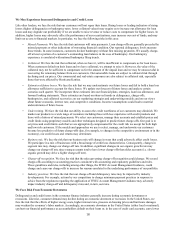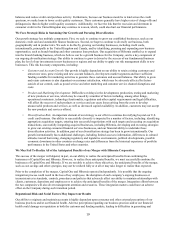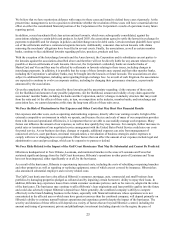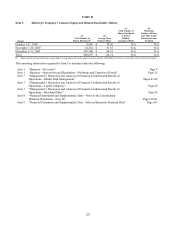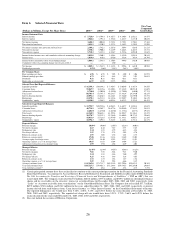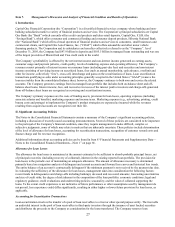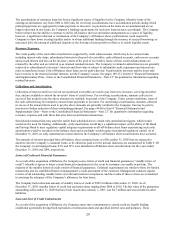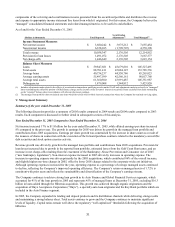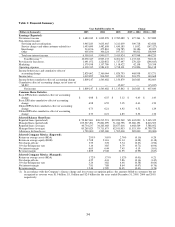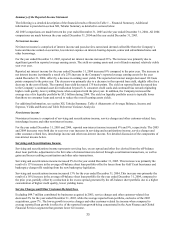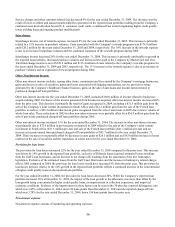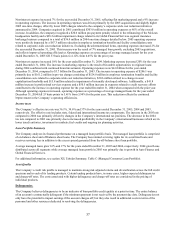Capital One 2005 Annual Report Download - page 37
Download and view the complete annual report
Please find page 37 of the 2005 Capital One annual report below. You can navigate through the pages in the report by either clicking on the pages listed below, or by using the keyword search tool below to find specific information within the annual report.receivables from the Consolidated Balance Sheets for securitizations that qualify as sales in accordance with Statement of
Financial Accounting Standards No. 140, Accounting for Transfers and Servicing of Financial Assets and Extinguishment of
Liabilities—a Replacement of FASB Statement No. 125 (“SFAS 140”). The trusts are qualified special purpose entities as
defined by SFAS 140 and are not subsidiaries of the Company and are not included in the Company’ s consolidated financial
statements. The gain on sale recorded from off-balance sheet securitizations is based on the estimated fair value of the assets
sold and retained and liabilities incurred, and is recorded at the time of sale, net of transaction costs. The related receivable is
the interest-only strip, which is based on the present value of the estimated future cash flows from excess finance charges and
past-due fees over the sum of the return paid to security holders, estimated contractual servicing fees and credit losses. Gains
on securitization transactions, fair value adjustments related to residual interests and earnings on the Company’ s
securitizations are included in servicing and securitizations income in the Consolidated Statements of Income and amounts
due from the trusts are included in accounts receivable from securitizations on the Consolidated Balance Sheets.
Certain estimates inherent in the determination of the fair value of the retained interests are influenced by factors outside the
Company’ s control, and as a result, such estimates could materially change and actual results could be materially different
from such estimates. Any future gains that will be recognized in accordance with SFAS 140 will be dependent on the timing
and amount of future securitizations. The Company intends to continuously assess the performance of new and existing
securitization transactions, and therefore the valuation of retained interests, as estimates of future cash flows change.
Rewards
The Company offers credit cards that provide reward program members with various rewards such as airline tickets, free or
deeply discounted products or cash rebates, based on purchase volume. The Company establishes a rewards liability based on
points earned which are ultimately expected to be redeemed and the average cost per point redemption. As points are
redeemed, the rewards liability is relieved. The cost of reward programs is reflected as a reduction to interchange income.
The rewards liability will be affected over time as a result of changes in the number of account holders in the reward
programs, the actual amount of points earned and redeemed, general economic conditions, the actual costs of the rewards,
changes made by reward partners and changes that the Company may make to the reward programs in the future. To the
extent assumptions used by management do not prevail, rewards costs could differ significantly, resulting in either a higher or
lower future rewards liability, as applicable.
F
inance Charge and Fee Revenue Recognition
The Company recognizes earned finance charges and fee income on loans according to the contractual provisions of the
credit arrangements. When the Company does not expect full payment of finance charges and fees, it does not accrue the
estimated uncollectible portion as income (hereafter the “suppression amount”). To calculate the suppression amount, the
Company first estimates the uncollectible portion of finance charge and fee receivables using a formula based on historical
account migration patterns and current delinquency status. This formula is consistent with that used to estimate the allowance
related to expected principal losses on reported loans. The suppression amount is calculated by adding any current period
change in the estimate of the uncollectible portion of finance charge and fee receivables to the amount of finance charges and
fees charged-off (net of recoveries) during the period. The Company subtracts the suppression amount from the total finance
harges and fees billed during the period to arrive at total reported revenue. c
The amount of finance charges and fees suppressed were $1.0 billion, $1.1 billion and $2.0 billion for the years ended
December 31, 2005, 2004 and 2003, respectively. The reduction in the suppression amount was driven by the Company’ s
continued asset diversification beyond U.S. consumer credit cards, a continued bias toward originating higher credit quality,
lower yielding loans, improved collections experience, ongoing product modifications and an overall improvement in general
economic conditions. These factors drove a reduction in total finance charges and fees billed during the period and increased
the likelihood of collectibility. Both the lower volume of finance charges and fees billed and the higher expectations of
collectibility drove the reduction in the amount of finance charges and fees suppressed. Actual payment experience could
differ significantly from management’ s assumption, resulting in higher or lower future finance charge and fee income.
II
I. Off-Balance Sheet Arrangements
O
ff-Balance Sheet Securitizations
As discussed in “Significant Accounting Policies—Accounting for Securitization Transactions,” the Company actively
engages in off-balance sheet securitization transactions of loans for funding purposes. The Company receives the proceeds
from third party investors for securities issued from the Company’ s securitization vehicles which are collateralized by
transferred receivables from the Company’ s portfolio. Securities outstanding totaling $45.3 billion as of December 31, 2005,
represent undivided interests in the pools of consumer loan receivables that are sold in underwritten offerings or in private
placement transactions.
28


